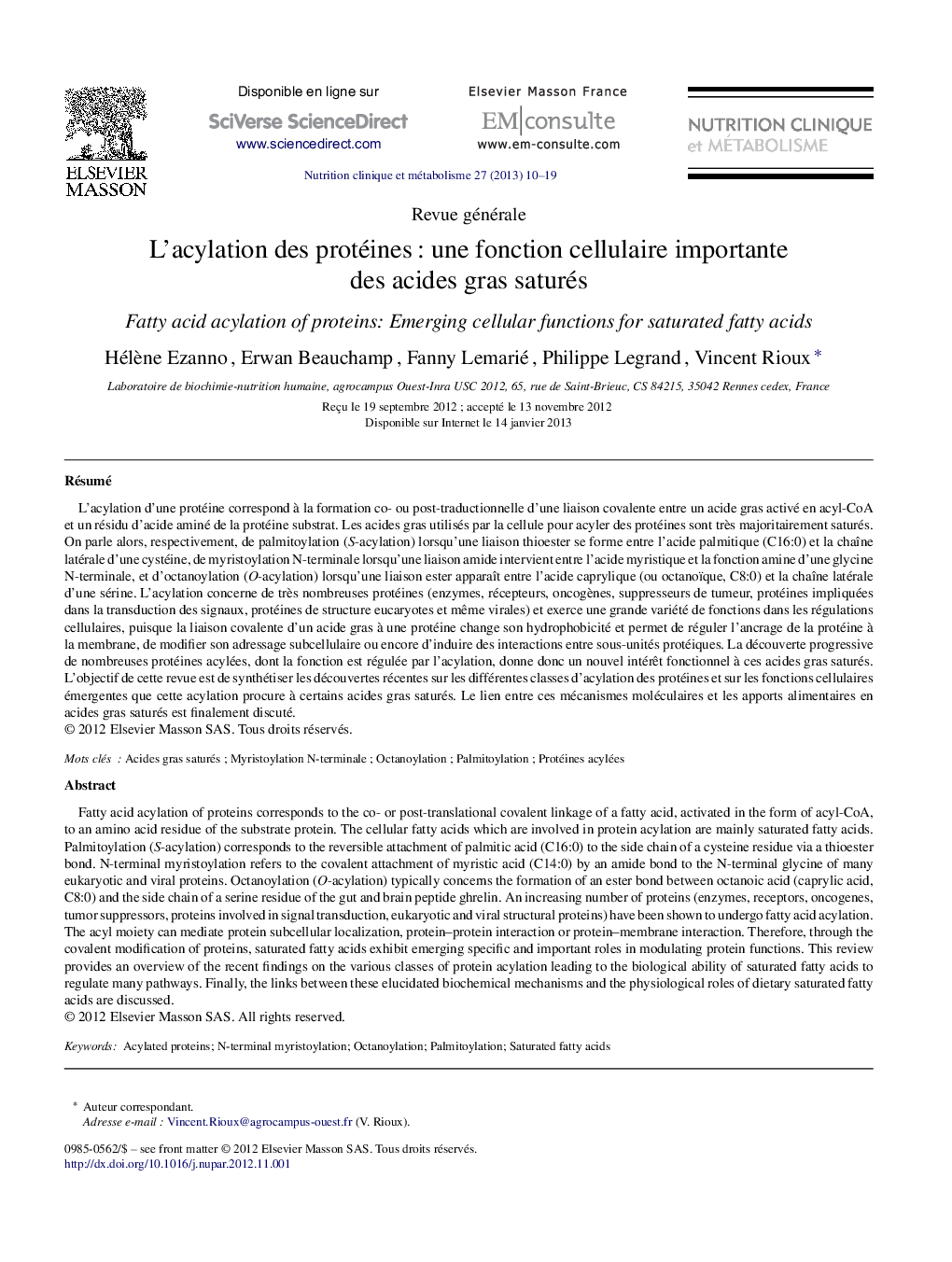| Article ID | Journal | Published Year | Pages | File Type |
|---|---|---|---|---|
| 2692886 | Nutrition Clinique et Métabolisme | 2013 | 10 Pages |
RésuméL’acylation d’une protéine correspond à la formation co- ou post-traductionnelle d’une liaison covalente entre un acide gras activé en acyl-CoA et un résidu d’acide aminé de la protéine substrat. Les acides gras utilisés par la cellule pour acyler des protéines sont très majoritairement saturés. On parle alors, respectivement, de palmitoylation (S-acylation) lorsqu’une liaison thioester se forme entre l’acide palmitique (C16:0) et la chaîne latérale d’une cystéine, de myristoylation N-terminale lorsqu’une liaison amide intervient entre l’acide myristique et la fonction amine d’une glycine N-terminale, et d’octanoylation (O-acylation) lorsqu’une liaison ester apparaît entre l’acide caprylique (ou octanoïque, C8:0) et la chaîne latérale d’une sérine. L’acylation concerne de très nombreuses protéines (enzymes, récepteurs, oncogènes, suppresseurs de tumeur, protéines impliquées dans la transduction des signaux, protéines de structure eucaryotes et même virales) et exerce une grande variété de fonctions dans les régulations cellulaires, puisque la liaison covalente d’un acide gras à une protéine change son hydrophobicité et permet de réguler l’ancrage de la protéine à la membrane, de modifier son adressage subcellulaire ou encore d’induire des interactions entre sous-unités protéiques. La découverte progressive de nombreuses protéines acylées, dont la fonction est régulée par l’acylation, donne donc un nouvel intérêt fonctionnel à ces acides gras saturés. L’objectif de cette revue est de synthétiser les découvertes récentes sur les différentes classes d’acylation des protéines et sur les fonctions cellulaires émergentes que cette acylation procure à certains acides gras saturés. Le lien entre ces mécanismes moléculaires et les apports alimentaires en acides gras saturés est finalement discuté.
Fatty acid acylation of proteins corresponds to the co- or post-translational covalent linkage of a fatty acid, activated in the form of acyl-CoA, to an amino acid residue of the substrate protein. The cellular fatty acids which are involved in protein acylation are mainly saturated fatty acids. Palmitoylation (S-acylation) corresponds to the reversible attachment of palmitic acid (C16:0) to the side chain of a cysteine residue via a thioester bond. N-terminal myristoylation refers to the covalent attachment of myristic acid (C14:0) by an amide bond to the N-terminal glycine of many eukaryotic and viral proteins. Octanoylation (O-acylation) typically concerns the formation of an ester bond between octanoic acid (caprylic acid, C8:0) and the side chain of a serine residue of the gut and brain peptide ghrelin. An increasing number of proteins (enzymes, receptors, oncogenes, tumor suppressors, proteins involved in signal transduction, eukaryotic and viral structural proteins) have been shown to undergo fatty acid acylation. The acyl moiety can mediate protein subcellular localization, protein–protein interaction or protein–membrane interaction. Therefore, through the covalent modification of proteins, saturated fatty acids exhibit emerging specific and important roles in modulating protein functions. This review provides an overview of the recent findings on the various classes of protein acylation leading to the biological ability of saturated fatty acids to regulate many pathways. Finally, the links between these elucidated biochemical mechanisms and the physiological roles of dietary saturated fatty acids are discussed.
